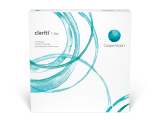From the Wall Street Journal to local news reports,1,2 you may have come across frequent stories as of late about myopia. Likewise, you may be fielding more questions about myopia from families coming into your practice.
Today, myopia has grown to epidemic proportions.3 Myopia is on the rise in the U.S. and across the world, and particularly amongst children.3 The World Vision Council cites that by 2050, about 50% of people across the globe will have myopia, and 20% will have high myopia,4 the latter of which encompasses prescriptions from -5.00 or -6.00D and greater.4,5
Myopia is a progressive and irreversible eye disease in which a person’s eye grows too long, too fast and the eye gets weaker. Myopia generally progresses the fastest when a child is young and stabilizes by their mid-to-late teenage years.6-8
Science Paints a Clearer Picture of Myopia
As children develop and grow, so do their eyes. Studies that have delved into childhood myopia have found that 96% of childhood myopia cases worsen as the child grows.9
Current research has provided a clearer understanding of myopia and how it affects the eye. Through modern science, we now understand that myopia isn’t merely a benign refractive error that can be corrected with a pair of single-vision glasses or contact lenses.7 These modes of vision correction can provide clear vision but don’t address the underlying myopia or protect against associated eye conditions and diseases, such as glaucoma, retinal tears and detachments, cataracts, and myopic maculopathy,10-13 all of which pose a greater level of risk in individuals with high myopia.7,11,14
Scientists also suggest that no level of myopia is safe.7 Studies have reported that people with even low levels of myopia (-0.75 to -3.00D) have up to a four times greater chance of a retinal detachment.7
Understand the Risk Factors
Myopia is believed to be caused by a combination of genetic and environmental factors, the latter of which includes a patient’s lifestyle.15
Considering genetics, a parent’s myopia status has been linked to their child’s risk of developing myopia.15 For example, a child’s risk of myopia is 1 in 2 if both parents have myopia.16 If only 1 parent has myopia, a child’s myopia risk is 1 in 3.16 If neither parent has myopia, a child still has a 1 in 4 chance of developing myopia.16
Additionally, children who have a parent with high myopia are more likely to develop myopia and progress to high myopia themselves.17 Children of parents with high myopia also progress faster in both spherical error and axial length.18 Scientists also believe that children with parents who have myopia have a greater chance of developing early onset myopia at a young age, regardless of race or ethnicity.19
Lifestyle and environmental factors have also been tied to myopia.20-24 One causative factor that has been closely explored is whether time spent outdoors can provide a protective mechanism against myopia. One investigation found increased outdoor time reduced the risk of myopia onset and myopic shifts, especially in nonmyopic children.20-23
Another study that included 693 first graders at 16 schools in Taiwan found those students who had been encouraged to spend at least 11 hours per week outside had less myopic shift and axial elongation compared to kids in the control group at the year endpoint.24
Other lifestyle influences have been shown to promote myopia development, including prolonged “near work.” This includes extended time spent on digital devices like phones and tablets, in addition to reading.21-23, 25
Even low lighting levels have been associated with myopia development.26
A First of Its Kind, FDA Approved* Treatment †9
Today, families can turn to a proven treatment to slow myopia progression.9 MiSight® 1 day is the first and only daily disposable soft contact lens approved by the FDA* to slow the progression of myopia in children aged 8-12 at the initiation of treatment. ‡9 MiSight® has been studied in children as young as 8 years old.9
Unlike a multifocal contact lens for adults with presbyopia, MiSight® 1 day is a dual focus, soft contact lens. MiSight® 1 day offers a two-in-one benefit by both correcting refractive error and slowing the elongation of the eye through ActivControl™ Technology.‡9 Two treatment zones in the lens create myopic defocus with image focus in front of the retina to slow axial elongation.‡9
Specifically, the ActivControl™ Technology in MiSight® 1 day utilizes an optic zone concentric ring design with alternating vision correction and treatment zones. Two zones are vision correction zones with the label power of the contact lens, and the alternating two zones are treatment zones with 2 diopters of defocus to slow the progression of myopia. This design allows the patient to see clearly while benefiting from the treatment effect.9,27,28
Studies have shown that hyperopic defocus can induce excessive eye growth and myopia while myopic defocus can slow down eye growth.9 Research has shown that eye growth can be manipulated when defocus, particularly myopic defocus, is presented simultaneously with an additional optical power.9
This is key, since addressing axial elongation, or eye growth, helps to reduce the risk of myopia-related vision complications later in life, including irreversible vision loss.29
MiSight® 1 day data has been collected for over 7 years.§30 In fact, the MiSight® 1 day clinical trial was the longest running study of soft contact lenses in children. Over a 3-year period, MiSight® 1 day slowed the progression of myopia in children by 59% on average, and 41% of eyes had no progression.|9 Additionally, on average, children in the study wearing MiSight® progressed less than -1.00D over 6 years.¶29
Visit the Online Success Center for further resources on myopia and MiSight® 1 day, including the MiSight® 1 day QuickStart program. And stay tuned for more articles for technicians and staff in the Myopia 101 series.
*Indications for Use: MiSight® (omafilcon A) daily wear single use Soft Contact Lenses are indicated for the correction of myopic ametropia and for slowing the progression of myopia in children with non-diseased eyes, who at the initiation of treatment are 8-12 years of age and have a refraction of -0.75 to -4.00 diopters (spherical equivalent) with ≤ 0.75 diopters of astigmatism. The lens is to be discarded after each removal.
†Only FDA approved soft contact lens designed for myopia control in the U.S.
‡Compared to a single vision 1 day lens over a 3-year period.
§Children with myopia fit with MiSight® 1 day contact lenses ages 8-15 continued to experience slowed myopia progression as long as they remained in treatment.
|Compared to single vision lens. -0.25D or less of change. Fitted at 8-12 years of age at initiation of treatment.
¶Fitted at 8-12 years of age at initiation of treatment.
References:
1. Wall Street Journal. Screens, Lack of Sun are Causing an Epidemic of Myopia. Aug. 26, 2023. https://www.wsj.com/tech/personal-tech/our-eyes-really-are-getting-worse-heres-how-to-save-your-kids-vision-de16d592.
2. Half the world’s population nearsighted by 2050? Eye experts warn of growing myopia epidemic. Boston 25 News. May 8, 2023. https://www.boston25news.com/news/local/half-worlds-population-nearsighted-by-2050-eye-experts-warn-growing-myopia-epidemic/G2TY5SCQFFG3LHQEYDCBYBVKRM/.
3. Myopia on the rise, especially among children. Casey Eye Institute. June 3, 2022.
4. Holden BA, Fricke TR, Wilson DA, et al. Global prevalence of myopia and high myopia and temporal trends from 2000 through 2050. Ophthalmology. 2016;123:1036–1042.
5. World Council of Optometry. https://worldcouncilofoptometry.info/global-myopia-awareness-coalition-gmac/.
6. Zadnik K, Mitchell GL, Jones LA, Mutti Doi. Factors associated with rapid myopia progression in school-aged children Invest Ophthalmol. Vis. Sci. 2004;45(13):2306.
7. Holden BA, Wilson DA, Jong M, et al. Myopia: a growing global problem with sight-threatening complications. Community Eye Health. 2015; 28(90): 35.
8. Lee SSY, Lingham G, Sanfilippo PG. et al. Incidence and Progression of Myopia in Early Adulthood. JAMA Ophthalmol. 2022;140(2):162-169.
9. Chamberlain P, et al. A 3-year randomized clinical trial of MiSight® lenses for myopia control. Optom Vis Sci. 2019;96(8):556-567.
10. Xu L, Wang Y, Wang S, Jonas JB. High myopia and glaucoma susceptibility, the Beijing Eye Study. Ophthalmology. 2007;114(2):216-20.
11. Flitcroft DJ. The complex interactions of retinal, optical and environmental factors in myopia aetiology. Progress in Retinal and Eye Research. 2012 Nov.;31(6):622-60.
12. Younan C, et al. Myopia and incident cataract and cataract surgery: the blue mountains eye study. Invest Ophthalmol Vis Sci. 2002;43(12):3625-3632.
13. Chen SJ, et al. Prevalence and associated risk factors of myopic maculopathy in elderly Chinese: the Shihpai eye study. Invest Ophthalmol Vis Sci. 2012;53(8):4868-73.
14. Bullimore M, Brennan NA. Myopia control: why each diopter matters. Optom Vis Sci. 2019 Jun;96(6):463-465.
15. Tedja MS, Haarman AEG, Meester-Smoor MA, et al. IMI–Myopia Genetics Report. Invest Ophthalmol Vis Sci. 2019 Feb; 60(3): M89–M105.
16. Morgan P. C52102: Is myopia control the next contact lens revolution? 2016. Available from https://www.opticianonline.net/cet-archive/127.
17. Haines C. Talking to a myopic adult about risk for their child. Myopia Profile. Nov. 30, 2021. https://www.myopiaprofile.com/articles/talking-to-a-myopic-adult-about-risks#:~:text=Having%20two%20parents%20whom%20both,in%20children%20by%20six%20times.&text=Children%20who%20have%20two%20myopic,onset%20by%20their%20teenage%20years.
18. Chimei Liao, Xiaohu Ding, Xiaotong Han, Yu Jiang, Jian Zhang, Jane Scheetz, Mingguang He; Role of Parental Refractive Status in Myopia Progression: 12-Year Annual Observation From the Guangzhou Twin Eye Study. Invest Ophthalmol Vis Sci. 2019;60(10):3499-3506.
19. Jiang X, Tarczy-Hornoch K, Cotter SA, et al. Association of parental myopia with higher risk of myopia among multiethnic children before school age. JAMA Ophthalmol. 2020;138(5):501-509.
20. He X, Sankaridurg P, Wange J, et al. Time outdoors in reducing myopia. Increasing outdoor time reduced the risk of myopia onset and myopic shifts, especially in nonmyopic children. Ophthalmol. 2022 Nov;129(11):1245-1254.
21. Xiong S, Sankaridurg P, Naduvilath T, Zang J, Zou H, 21.Zhu J, Lv M, He X, Xu X. Time spent in outdoor activities in relation to myopia prevention and control: a meta-analysis and systematic review. Acta Ophthalmol. 2017 Sep;95(6):551-566. doi: 10.1111/aos.13403.
22. Huang HM, Chang DS, Wu PC. The Association between Near Work Activities and Myopia in Children-A Systematic Review and Meta-Analysis. PLoS One. 2015 Oct 20;10(10):e0140419. doi: 10.1371/journal.pone.0140419.
23. Lanca C, Saw SM. The association between digital screen time and myopia: A systematic review. Ophthalmic Physiol Opt. 2020 Mar;40(2):216-229. doi: 10.1111/opo.12657.
24. Wu PC, Chen CT, Lin KK, et a. Myopia Prevention and Outdoor Light Intensity in a School-Based Cluster Randomized Trial. Ophthalmology. 2018 Aug;125(8):1239-1250.
25. Foreman J, Tjitra Salim A, Praveen A, et al. Association between digital smart device use and myopia: a systematic review and meta-analysis. The Lancet Digital Health. 2021 Dec;3(12):e806-e818.
26. Dim Landis EG, Yang V, Brown DM, et al. Dim Light Exposure and Myopia in Children. Invest Ophthalmol Vis Sci. 2018 Oct; 59(12): 4804–4811.
27. Sulley A et al, Wearer experience and subjective responses with dual focus compared to spherical, single vision soft contact lenses in children during a 3-year clinical trial. AAO 2019 Poster Presentation.
28. Chamberlain P et al, Further comparison of myopia progression in new and established myopia control treatment (MiSight® 1 day) groups. BCLA paper presentation 2019.
29. CVI Data on file, 2022.
30. Chamberlain P, Arumugam B, Jones D et al. Myopia Progression in Children wearing Dual-Focus Contact Lenses: 6-year findings. Optom Vis Sci 2020;97(E-abstract): 200038.







